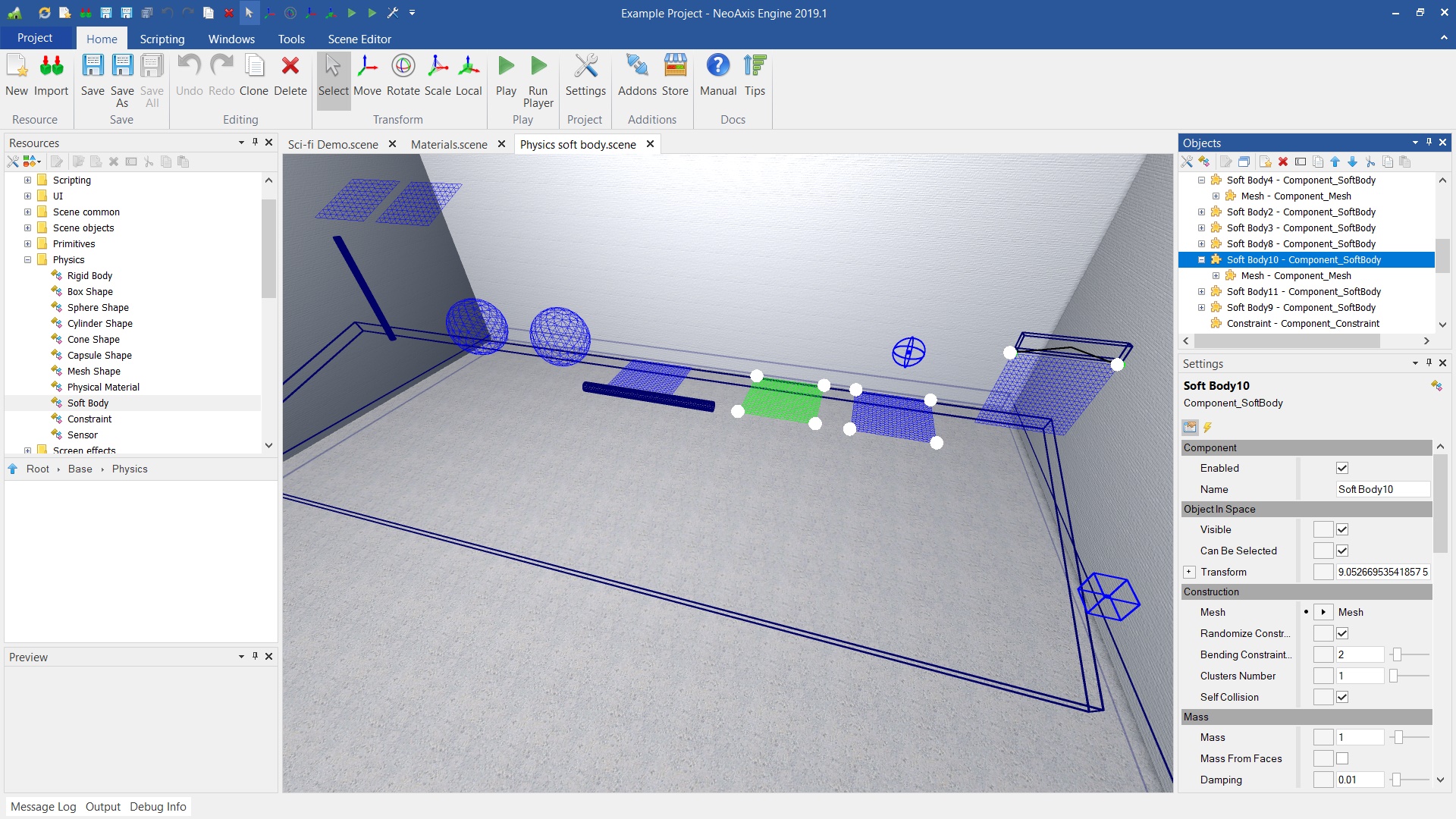| Name
| Description
|
|---|
| Mesh
| The mesh used by the soft body.
|
| Randomize Constraints
| Whether to randomize constraints to reduce solver bias.
|
| Bending Constraint Distance
| The distance between two vertices that produce tension on a surface. Greater distance produces softer physical body.
|
| Clusters Number
| The number of collision clusters generated.
|
| Self Collision
| Causes the solver to detect and resolve collisions between different parts of the same soft body, such as when a patch of cloth folds back on itself.
|
| Mass
| The mass of the soft body.
|
| Mass From Faces
| Whether to use mass scaling factor for each vertex.
|
| Damping
| The damping factor applied to the overall motion of the soft body. Too much damping prevents the soft body from moving.
|
| Pressure
| Determines how strongly a closed soft body, such as a sphere, maintains its shape and volume. High Pressure values cause the body to expand, while low Pressure values cause it to collapse.
|
| Drag
| Controls the amount of drag acting on the soft body as it moves through the air.
|
| Lift
| Controls the amount of lift that is generated as the soft body moves through the air.
|
| Body Aero Model
| The aero model of the soft body.
|
| Shape Matching
| When activated, the soft body tries to maintain its original shape.
|
| Shape Coefficient
| Pose matching coefficient [0,1]. Specifies the degree to which the rigid body attempts to maintain its shape. Higher Shape Coefficient values cause the rigid body to adhere more strictly to its original shape. If the values are too high, the soft body may penetrate or even fall through other objects.
|
| Volume Matching
| When on, the soft body tries to maintain its original volume.
|
| Volume Coefficient
| Specifies the degree to which the rigid body attempts to maintain its initial volume. The higher Volume Coefficient value, the more the soft body resists changes to its original volume. High Volume Coefficient values can cause the simulation to become unstable.
|
| Max Volume Ratio
| Max volume ratio for volume-based pose matching.
|
| Material
| The physical material used by the soft body.
|
| Material Friction
| The friction of the physical material.
|
| Material Linear Stiffness
| The stiffness of the physical material. The stiffness decides how hard the soft body will be during the collision.
|
| Material Angular Stiffness
| The angular stiffness of the physical material.
|
| Material Volume Stiffness
| The stiffness volume of the physical material.
|
| Rigid Contact Hardness
| The amount of penetration correction applied to contacts with rigid bodies.
|
| Soft Rigid Contact Hardness
| Soft vs rigid hardness [0,1] (cluster only).
|
| Kinetic Contact Hardness
| The amount of penetration correction applied to contacts with static bodies.
|
| Soft Rigid Impulse Split
| Soft vs rigid impulse split [0,1] (cluster only).
|
| Soft Soft Impulse Split
| Soft vs soft impulse split [0,1] (cluster only).
|
| Soft Kinetic Impulse Split
| Soft vs kinetic impulse split [0,1] (cluster only).
|
| Soft Kinetic Contact Hardness
| Soft vs kinetic hardness[0,1] (cluster only).
|
| Soft Soft Contact Hardness
| Soft vs soft hardness [0,1] (cluster only).
|
| Soft Contact Hardness
| The amount of penetration correction applied to contacts with other soft bodies.
|
| Anchor Contact Hardness
| The amount of correction is applied to follow anchor constraints.
|
| Position Iterations
| The number of position iterations performed during soft body simulation.
|
| Velocity Iterations
| The number of velocity iterations performed during soft body simulation.
|
| Drift Iterations
| The number of drift iterations performed during soft body simulation.
|
| Cluster Iterations
| The number of collision cluster iterations performed during soft body simulation.
|
| Collision Margin
| The minimum allowable distance between cloth and collision object.
|
| Velocity Correction Factor
| The amount of velocity correction applied on the soft body.
|
| Time Scale
| The time scale of the soft body simulation.
|
| Collision Group
| The collision filter group of the soft body.
|
| Collision Mask
| The collision filter mask of the soft body.
|
| Linear Velocity
| The initial linear velocity of the soft body.
|
